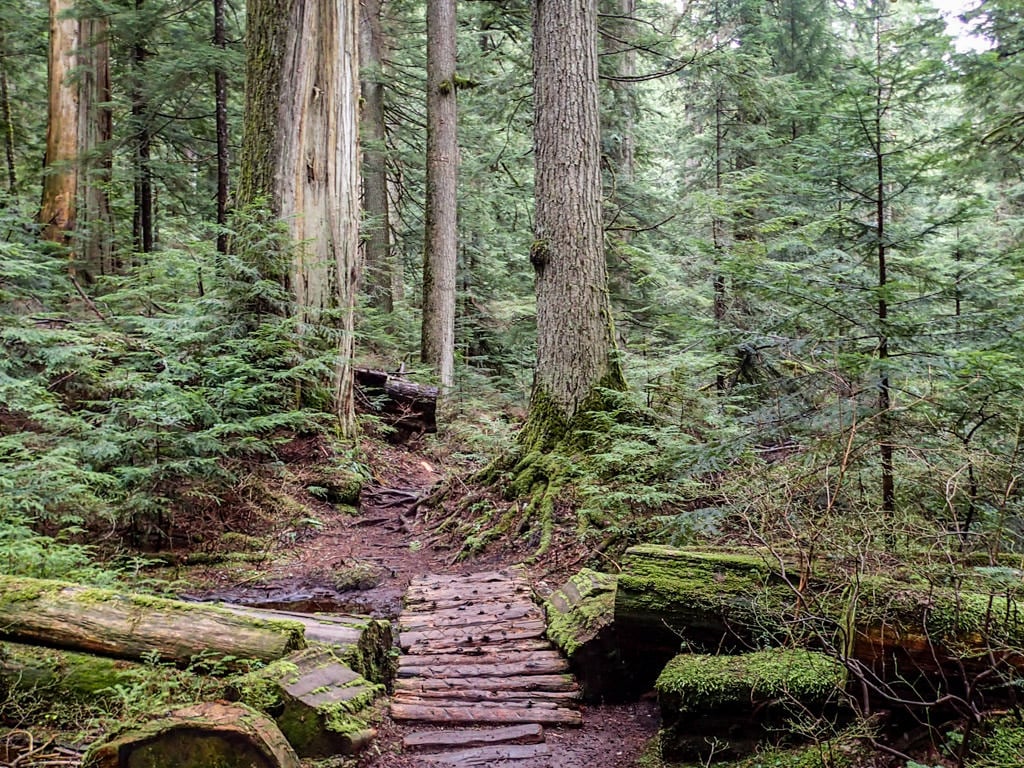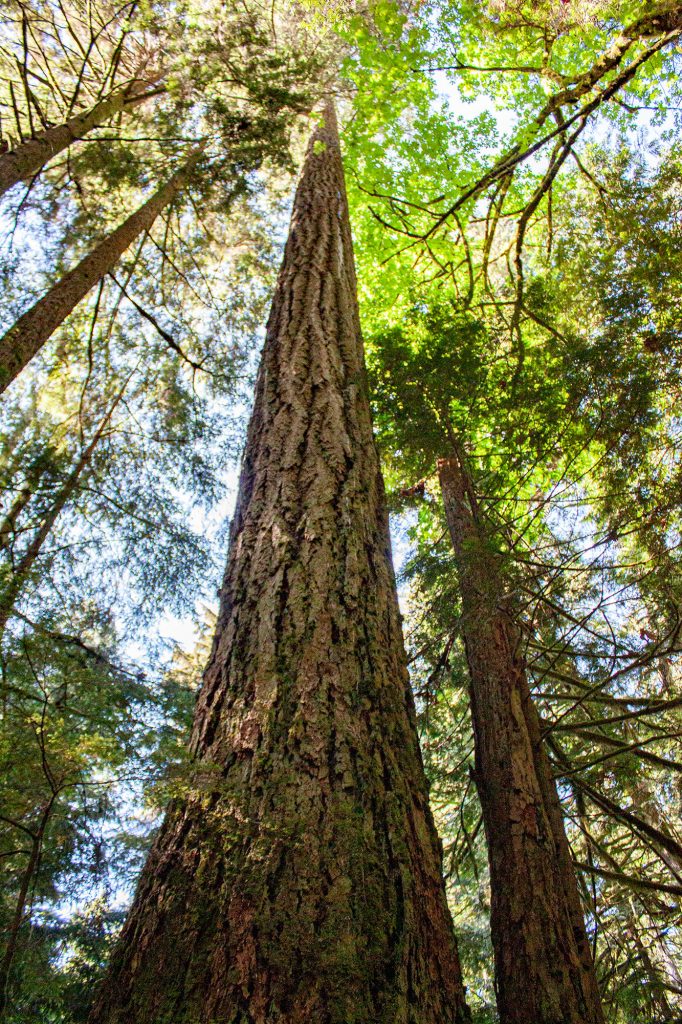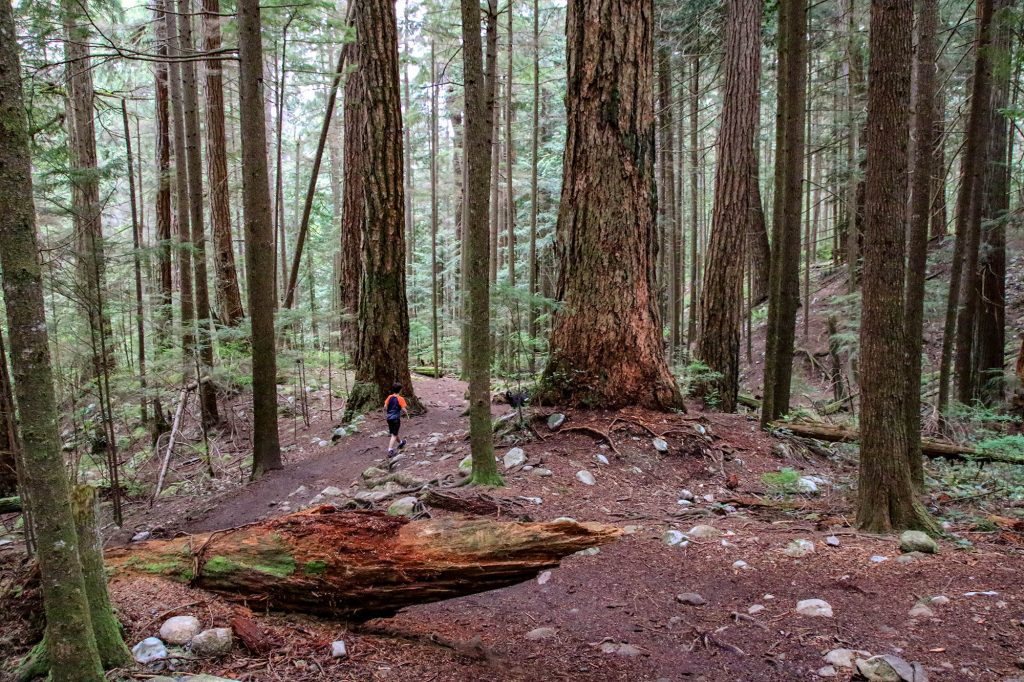The Best Hikes Near Vancouver to See Big Trees
The mild coastal climate of southwestern BC is great at growing trees. In fact, BC sits in the middle of the world’s largest temperate rainforest, stretching from Northern California to Alaska. Logging and forest fires have wiped out much of the old-growth, but there are still pockets of huge ancient trees to be found. Here are 14 places you can hike to big trees near Vancouver.

Stanley Park
Although it might not seem like wilderness, Stanley Park is actually a great place to spot some giant trees. Head into the forested interior of the park, tilt your head up and see how many big trees you can find. The Tatlow Walk trail is a great place to start. Don’t miss the 600-year-old douglas fir near the intersection of Cathedral Trail and Bridle Path.
Foreshore Trail
While most of Pacific Spirit Park near UBC is second-growth forest, some old-growth gems are hiding in plain sight. Walk the Foreshore Trail to Wreck Beach, then take the Trail 6 stairs up to Marine Drive. There are several huge old-growth cedars and firs along the trail. Near the road, look for a huge 46m-tall douglas fir with a forked top.
Whyte Lake
The hike to Whyte Lake in West Vancouver travels along the rim of Nelson Creek Canyon. It’s a beautiful section of rainforest with lots of ferns and moss. Keep an eye out for some giant douglas firs, especially in the first section before you cross the bridge over Nelson Creek.

Lighthouse Park
Many visitors to West Vancouver’s Lighthouse Park make a beeline for the lighthouse. But if you explore the forested trails away from the crowds, you’ll find lots of huge douglas firs and cedars. Some of the best places to spot them are the Seven Sisters Trail near the junction with Lady Fern Path, Avenue of the Giants Trail, and Valley Trail. Some of the western red cedars, douglas firs and yellow cedars along the Valley Trail are over 600 years old.

Cypress Falls
West Vancouver’s Cypress Falls Trail is known for its waterfalls. But it’s actually a great place to see big trees too. Look for 300-year-old stands of red cedar and douglas fir trees on the west side of the creek in between the two main waterfalls.

Yew Lake
If you’re headed to Bowen Lookout in Cypress Provincial Park, make a short detour onto the Yew Lake Trail. It’s a flat 2km loop designed to be accessible for wheelchairs and people with mobility aids. There are lots of interpretive signs to teach you about the flora and fauna. But if you’re after big trees, head to the Old Growth Loop spur trail at the northwest end of the loop. It’s a small, but beautiful grove of huge douglas firs and cedars.
Brothers Creek
The Brothers Creek Loop in West Vancouver heads up into the forest above the British Properties. Most of the forest is second-growth, but there are a few old-growth giants to be found as well. Follow a short spur trail partway up the Brothers Creek Fire Road to find the Candelabra Fir. Enjoy the big grove of douglas firs on the Brothers Creek Trail in between the former bridge site and the junction with the Crossover Trail. And if you have time, make a detour over to the Hollyburn Fir at the intersection of the Crossover and Brewis Trails. This giant is 1100 years old, has a circumference of 10m, and is 44m tall!

Capilano Canyon
There are several huge douglas fir trees along the trails in Capilano Canyon. The highlight is Grandpa Capilano, a huge douglas fir with a diameter of 2.4 meters. It used to be very tall, but wind and age have broken off its top. You can spot the tree on the aptly named Giant Fir Trail.

The Big Cedar
The hike to the Big Cedar and Kennedy Falls in North Vancouver is rugged but worth it. The trail follows a muddy and rooty abandoned logging road up the Lynn Creek Valley. Your goal is the Big Cedar, which is said to be over 600 years old and has a diameter of about 4 meters. It wasn’t logged along with the surrounding forest since it forks into several trunks instead of standing straight and tall. If you continue past the cedar, you’ll reach Kennedy Falls.

Hidden Grove
The easy hike through Hidden Grove in Sechelt leads to lots of big trees. The network of volunteer-built trails celebrates several huge old trees that have withstood time and the pressures of logging. Locals have given the big trees evocative names like “Survivor”, “Lonely Giant” and “Sentinel”.
Ancient Cedars
If you’re in Whistler and you like big trees, head north of town to the Ancient Cedars Trail. The 5km-long trail leads to a grove of huge cedars, said to be over 900 years old. Local volunteers have installed interpretive signs to help you learn about these beautiful giants.
Seven Sisters
The Seven Sisters Trail in Cultus Lake Provincial Park is a short and easy hike that takes you to a grove of seven douglas fir trees. Four of the trees have succumbed to age, but three are still standing tall and proud. Be sure to stay on the boardwalks and behind the fences. Walking on the roots of these giants damages them.
Frosty Mountain
Manning Park’s Frosty Mountain is the highest peak in the park. But just below the peak, you’ll find a grove of larch trees. These trees aren’t particularly large, but they are special. Some of the trees in this grove are over 1000 years old, but they don’t look like it since they grow so slowly at such a high elevation. The long needles of these trees are also unique: each autumn they turn yellow and fall off, making the larch a coniferous tree that isn’t evergreen! Visit in late September or early October to see the larches change from green to gold.
Taryn Eyton is a Squamish-based outdoor and adventure travel writer and Leave No Trace Master Educator. She is the founder of the hiking website HappiestOutdoors.ca and the author of Backpacking in Southwestern British Columbia: The Essential Guide to Overnight Hiking Trails (Greystone Books, 2021).

Comments that gratuitously attack or demean individuals or organizations are not acceptable. We reserve the right to remove comments or any other content we deem unacceptable in our sole discretion, including removing user names and profile pictures. For our full website terms and conditions including our legal guidelines for user postings and comments on www.vancouvertrails.com, please see our Terms of Use and Privacy Policy.